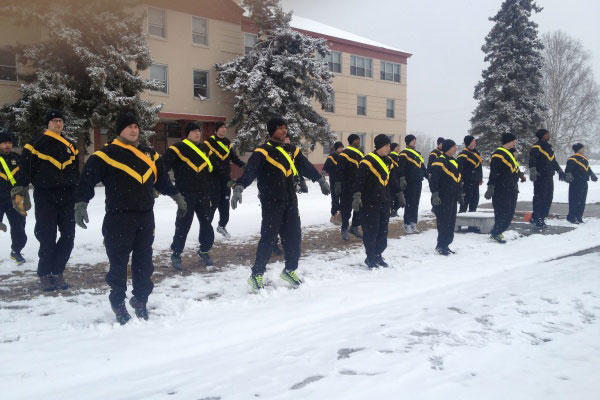The U.S. Army rolled out its new physical fitness uniform Monday. The new black and gold Army Physical Fitness Uniform, or APFU, will replace the current black and gray Improved Physical Fitness Uniform in 2017.
The APFU consists of a jacket, long pants, shorts, short-sleeve T-shirt and long-sleeve T-shirt. The new uniform is scheduled to cost about $3 less than the current uniform, Army officials said.
"Its design is based on soldier feedback," Col. Robert Mortlock, program manager, Soldier Protection and Individual Equipment, said in an Aug. 11 press release.
The Army launched the APFU program after a February 2012 Army Knowledge Online survey of some 76,000 soldiers found that soldiers had issues with the IPFU, he said. They liked its durability but believed the IPFU's textiles had not kept pace with commercially-available workout clothes.
Soldiers, both male and female, also had concerns with other things, particularly modesty issues with the shorts, especially in events like sit-ups, Army officials said. The issue was of such concern that soldiers were purchasing spandex-like under garments to wear beneath the trunks, Mortlock said.
Another issue was that there were not enough female sizes in the IPFU, he said. The APFU introduces multiple sizes, including female sizing, and has solved the modesty issue, Mortlock said.
PEO Soldier worked closely with the Natick Soldier Research Development and Engineering Center to develop a new PT uniform that met soldier concerns but did not cost more than the IPFU. The APFU met the goal of controlling costs and improving performance by adopting lighter high-tech moisture wicking fabric, Army officials said.
The fabric of the trunks will continue to be made with durable nylon fabric, but it is lighter than and not as stiff as the IPFU trunks. Also, there will be a four-way stretch panel inside the trunks, sort of like bicycle pants, which eliminates the need for soldiers to purchase their own under garments. The trunks include a bigger key pocket and an ID card pouch.
In all, some 34 changes were made to the new APFU. Officials said soldier feedback determined the form, fit and function of the APFU, but it also determined its look. Soldier feedback was also solicited about the design features as well as the preferred color scheme.
The Army made prototypes of the APFU in a variety of colors and designs and taken to a series of soldier town halls at Fort Hood, Texas; Fort Bragg, North Carolina; and Joint Base Lewis-McChord, Washington.
Then, the Army launched a second AKO survey, in which more than 190,000 responded, Mortlock said. Soldiers overwhelmingly favored a black T-shirt with gold lettering and a black jacket with gold chevron and the Army logo.
About 876 Soldiers at Fort Wainwright, Alaska, Join Base Lewis-McChord, Fort Bragg, Fort Sill, Oklahoma, Fort Hood and Fort Jackson, South Carolina, wore the APFU during PT for a three-month period, providing feedback on areas such as form, fit, comfort, Mortlock said. The APFU also was tested for things like durability, laundering, fiber strength, color fastness and color maintenance after laundering.
A key part of testing addressed the concern of some soldiers that a black shirt may cause over-heating. Instrumented tests showed that the lighter weight material and superior moisture wicking fabric more than compensated for any increased heat from the dark material, Army officials said.
The response to the APFU was "overwhelmingly positive," Mortlock said, particularly with the trunks.
The APFU will come in two types, the Clothing Bag variant, and the Optional APFU, which will be visually the same as the APFU Issue variant, but uses some different materials. The individual items of the two variants can be mixed together. The Optional APFU variant will become available first when it arrives in Army military clothing sales stores sometime between October-December 2014.
The Clothing Bag issue variant will be issued to soldiers from the clothing initial issue points, starting between April to June 2015, and to Reserve, National Guard, and Senior ROTC from July-August 2015. The APFU will be phased in as the IPFUs are used up and worn out. The mandatory wear date will go into effect approximately October 2017, or about three years after the APFU is introduced.
The Army reached out to soldiers at "multiple touch points to ensure we got this right," Mortlock said. "The message is we're listening to soldiers. We're continuing to listen to Soldiers, and this is the soldiers' selection and Army leaders went along with this."
-- Matthew Cox can be reached at Matthew.Cox@monster.com.


























